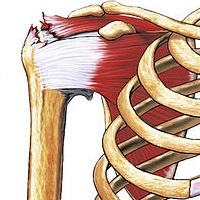
Photo from wikipedia
Rotator cuff disease, external and internal impingement syndromes, low shoulder stability, various types of trauma, and overuse injuries are all related to sports activities. In order to check symptoms in… Click to show full abstract
Rotator cuff disease, external and internal impingement syndromes, low shoulder stability, various types of trauma, and overuse injuries are all related to sports activities. In order to check symptoms in patients with disability and shoulder pain, clinicians use different methods and diagnostic imaging assessment. The research is aimed at evaluating whether there is a difference between provocation function tests (PFT) and ultrasonographic (US) testing of muscles within the rotator cuff in elite collegiate athletes. Patients (n = 184) were recruited from university team sports selections and tested with a standardized US examination of the shoulder and five PFTs (Speed's test, Neer's test, Hawkins test, lift-off test, Yergason's test). Based on the VAS pain assessment scale, 60 subjects had some pain, which was taken for further processing in the work (124 subjects did not have the presence of pain and were excluded from further processing). The US examination was conducted using Voluson 730 apparatus, by a linear probe, with the frequency in the range of 6-12 MHz. The chi-square test showed significant differences between PFT and the occurrence of shoulder muscle tendinitis for the following variables: Speed's test and subscapularis tendinitis (p = 0.02) and Speed's test and infraspinatus tendinitis (p = 0.01); Neer test and biceps brachii caput longum tendinitis (p = 0.01), Neer test and supraspinatus tendinitis (p = 0.02) and Neer test and infraspinatus tendinitis (p = 0.01); lift-off test and subscapularis tendinitis (p = 0.05); and Yergason's test and biceps brachii caput longum tendinitis (p = 0.03) and Yergason's test and subscapitis tendinitis (p = 0.01). The greatest effect of differences was observed in Neer's test and biceps brachii caput longum tendinitis (φ = 0.60), while the other effects can be described as medium and small in most cases. It can be concluded that functional tests are good predictors of soft tissue changes in the muscles of the rotator cuff of the shoulder. Further monitoring and analysis are needed on a larger number of athletes.
Journal Title: BioMed Research International
Year Published: 2022
Link to full text (if available)
Share on Social Media: Sign Up to like & get
recommendations!